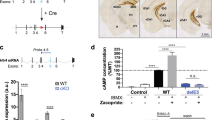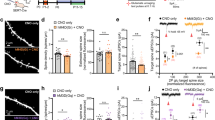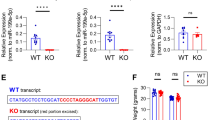Abstract
Pharmacological modulation of synaptic efficacy is a prominent target in the identification of promnesic compounds. Here, we report that pretraining administration of the serotonin 5-HT4 receptors (5-HT4Rs) partial agonist SL65.0155 enhances simultaneous olfactory discrimination performance and potentiates learning-induced dendritic spine growth in the mouse hippocampus. SL65.0155 does not affect spine density in the pseudo-trained mice and, by itself, does not promote spine growth. Injecting the 5-HT4 antagonist RS39604 prior to SL65.0155 prevents both the increase in performance and the additional formation of spines, thus confirming the 5-HT4Rs specificity of the observed effects. These findings provide evidence that 5-HT4Rs stimulation selectively increases experience-dependent structural plasticity in learning-activated hippocampal circuits.
Similar content being viewed by others
Log in or create a free account to read this content
Gain free access to this article, as well as selected content from this journal and more on nature.com
or
References
Barthet G, Framery B, Gaven F, Pellissier L, Reiter E, Claeysen S et al. (2007). 5-HT4 receptor activation of the ERK pathway depends on Src activation but not on G protein or beta-arrestin signaling. Mol Biol Cell 6: 1979–1991.
Bickmeyer U, Heine M, Manzke T, Richter DW (2002). Differential modulation of I(h) by 5-HT receptors in mouse CA1 hippocampal neurons. Eur J Neurosci 16: 209–218.
Bockaert J, Claeysen S, Compan V, Dumuis A (2004). 5-HT4 receptors. Curr Drug Targets CNS Neurol Disord 3: 39–51.
Dumuis A, Bouhelal R, Sebben M, Bockaert J (1988). A 5-HT receptor in the central nervous system, positively coupled with adenylate cyclase, is antagonized by ICS 205 930. Eur J Pharmacol 146: 187–188.
Eichenbaum H (2004). Hippocampus: cognitive processes and neural representations that underlie declarative memory. Neuron 44: 109–120.
Eichenbaum H, Fagan A, Mathews P, Cohen NJ (1988). Hippocampal system dysfunction and odor discrimination learning in rats: impairment or facilitation depending on representational demands. Behav Neurosci 102: 331–339.
Gibb R, Kolb B (1998). A method for vibratome sectioning of Golgi-Cox stained whole rat brain. J Neurosci Methods 79: 1–4.
Glaser EM, Van der Loos H (1981). Analysis of thick brain sections by obverse-reverse computer microscopy: application of a new, high clarity Golgi-Nissl stain. J Neurosci Methods 4: 117–125.
Huang YY, Kandel ER (2007). 5-Hydroxytryptamine induces a protein kinase A/mitogen-activated protein kinase-mediated and macromolecular synthesis-dependent late phase of long-term potentiation in the amygdala. J Neurosci 27: 3111–3119.
Kaibara T, Leung LS (1993). Basal vs apical dendritic long-term potentiation of commissural afferents to hippocampal CA1: a current-source density study. J Neurosci 13: 2391–2404.
Kemp A, Manahan-Vaughan D (2005). The 5-hydroxytryptamine4 receptor exhibits frequency-dependent properties in synaptic plasticity and behavioural metaplasticity in the hippocampal CA1 region in vivo. Cereb Cortex 15: 1037–1043.
Knafo S, Libersat F, Barkai E (2005). Dynamics of learning-induced spine redistribution along dendrites of pyramidal neurons in rats. Eur J Neurosci 21: 927–935.
Kulla A, Manahan-Vaughan D (2002). Modulation by serotonin 5-HT(4) receptors of long-term potentiation and depotentiation in the dentate gyrus of freely moving rats. Cereb Cortex 12: 150–162.
Kushner SA, Elgersma Y, Murphy GG, Jaarsma D, van Woerden GM, Hojjati MR et al. (2005). Modulation of presynaptic plasticity and learning by the H-ras/extracellular signal-regulated kinase/synapsin I signaling pathway. J Neurosci 25: 9721–9734.
Leuner B, Falduto J, Shors TJ (2003). Associative memory formation increases the observation of dendritic spines in the hippocampus. J Neurosci 23: 659–665.
Marchetti E, Chaillan FA, Dumuis A, Bockaert J, Soumireu-Mourat B, Roman FS (2004). Modulation of memory processes and cellular excitability in the dentate gyrus of freely moving rats by a 5-HT4 receptors partial agonist, and an antagonist. Neuropharmacology 47: 1021–1035.
Marchetti E, Dumuis A, Bockaert J, Soumireu-Mourat B, Roman FS (2000). Differential modulation of the 5-HT(4) receptor agonists and antagonist on rat learning and memory. Neuropharmacology 39: 2017–2027.
Micale V, Marco Leggio G, Mazzola C, Drago F (2007). Cognitive effects of SL65.0155, a serotonin 5-HT(4) receptor partial agonist, in animal models of amnesia. Brain Res 1121: 207–215.
Morris RG, Moser EI, Riedel G, Martin SJ, Sandin J, Day M et al. (2003). Elements of a neurobiological theory of the hippocampus: the role of activity-dependent synaptic plasticity in memory. Philos Trans R Soc Lond B Biol Sci 358: 773–786.
Moser MB, Trommald M, Egeland T, Andersen P (1997). Spatial training in a complex environment and isolation alter the spine distribution differently in rat CA1 pyramidal cells. J Comp Neurol 380: 373–381.
Moser PC, Bergis OE, Jegham S, Lochead A, Duconseille E, Terranova JP et al. (2002). SL65.0155, a novel 5-hydroxytryptamine(4) receptor partial agonist with potent cognition-enhancing properties. J Pharmacol Exp Ther 302: 731–741.
Muller D, Toni N, Buchs PA (2000). Spine changes associated with long-term potentiation. Hippocampus 10: 596–604.
Myers CE, Gluck MA (1996). Cortico-hippocampal representations in simultaneous odor discrimination: a computational interpretation of Eichenbaum, Mathews, and Cohen (1989). Behav Neurosci 110: 685–706.
Orsetti M, Dellarole A, Ferri S, Ghi P (2003). Acquisition, retention, and recall of memory after injection of RS67333, a 5-HT(4) receptor agonist, into the nucleus basalis magnocellularis of the rat. Learn Mem 10: 420–426.
Paxinos G, Franklin KBJ (2001). The Mouse Brain in Stereotaxic Coordinates, 2nd edn. Academic Press: San Diego.
Restivo L, Roman FS, Ammassari-Teule M, Marchetti E (2006). Simultaneous olfactory discrimination elicits a strain-specific increase in dendritic spines in the hippocampus of inbred mice. Hippocampus 16: 472–479.
Roman FS, Marchetti E, Bouquerel A, Soumireu-Mourat B (2002). The olfactory tubing maze: a new apparatus for studying learning and memory processes in mice. J Neurosci Methods 117: 173–181.
Skeberdis VA, Chevaleyre V, Lau CG, Goldberg JH, Pettit DL, Suadicani SO et al. (2006). Protein kinase A regulates calcium permeability of NMDA receptors. Nat Neurosci 9: 501–510.
Spencer JP, Brown JT, Richardson JC, Medhurst AD, Sehmi SS, Calver AR et al. (2004). Modulation of hippocampal excitability by 5-HT4 receptor agonists persists in a transgenic model of Alzheimer's disease. Neuroscience 129: 49–54.
Swanson LW, Wyss JM, Cowan WM (1978). An autoradiographic study of the organization of intrahippocampal association pathways in the rat. J Comp Neurol 181: 681–715.
Torres GE, Arfken CL, Andrade R (1996). 5-Hydroxytryptamine4 receptors reduce after hyperpolarization in hippocampus by inhibiting calcium-induced calcium release. Mol Pharmacol 50: 1316–1322.
Toth K, Freund TF (1992). Calbindin D28k-containing nonpyramidal cells in the rat hippocampus: their immunoreactivity for GABA and projection to the medial septum. Neuroscience 49: 793–805.
Tyler WJ, Pozzo-Miller L (2003). Miniature synaptic transmission and BDNF modulate dendritic spine growth and form in rat CA1 neurones. J Physiol 553: 497–509.
Tyler WJ, Pozzo-Miller LD (2001). BDNF enhances quantal neurotransmitter release and increases the number of docked vesicles at the active zones of hippocampal excitatory synapses. J Neurosci 21: 4249–4258.
White NM, McDonald RJ (2002). Multiple parallel memory systems in the brain of the rat. Neurobiol Learn Mem 77: 125–184.
Acknowledgements
The authors thank the three anonymous reviewers for their helpful criticism and comments on this paper.
Author information
Authors and Affiliations
Corresponding author
Additional information
Disclosure/Conflict of Interest
The authors declare that, except for income from their primary employer, no financial support or compensation has been received from any individual or corporate entity over the past 3 years for research or professional service and there are no personal financial holdings that could be perceived as constituting a potential conflict of interest.
Supplementary Information accompanies the paper on the Neuropsychopharmacology website (http://www.nature.com/npp)
Rights and permissions
About this article
Cite this article
Restivo, L., Roman, F., Dumuis, A. et al. The Promnesic Effect of G-protein-Coupled 5-HT4 Receptors Activation Is Mediated by a Potentiation of Learning-Induced Spine Growth in the Mouse Hippocampus. Neuropsychopharmacol 33, 2427–2434 (2008). https://doi.org/10.1038/sj.npp.1301644
Received:
Revised:
Accepted:
Published:
Issue date:
DOI: https://doi.org/10.1038/sj.npp.1301644
Keywords
This article is cited by
-
The role of serotonin neurotransmission in rapid antidepressant actions
Psychopharmacology (2022)
-
Déjà-vu? Neural and behavioural effects of the 5-HT4 receptor agonist, prucalopride, in a hippocampal-dependent memory task
Translational Psychiatry (2021)
-
Serotonin 5-HT4 receptor boosts functional maturation of dendritic spines via RhoA-dependent control of F-actin
Communications Biology (2020)



